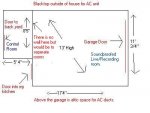thelivingexampl
New member
Halo..
I posted a message earlier about possibly building an addition on my house, and got some great advice, but that may not be possible now. My garage may be my last hope of a room that may accomodate this studio project. I will attempt to attach a JPG of a horrible drawing of my garage and dimensions. I was told by someone that the control room may not have to be soundproofed if the monitors are not very big. 9 times out of 10 I will be the one playing instruments and won't be in there monitoring anyway, so that isn't a big deal. My mian concern again is soundproofing so my neighbors don't call the cops at 3am while I am playing my drums.
Please take a look at the pic and let me know, albeit a teeny control room and close to getting there small live/recording room, if I can soundproof it, buy an AC unit, and fit a drum kit, a full guitar stack, a bass stack, vocal amp and lik 3 stools in the live room for $10,000(I already own the music gear)
Thanks again in advance for everyone's advice/experience.
Also, someone mentioned heatpumps for AC and heat, do they make ones that aren't 10 grand each?
Thanks,
Jim
I posted a message earlier about possibly building an addition on my house, and got some great advice, but that may not be possible now. My garage may be my last hope of a room that may accomodate this studio project. I will attempt to attach a JPG of a horrible drawing of my garage and dimensions. I was told by someone that the control room may not have to be soundproofed if the monitors are not very big. 9 times out of 10 I will be the one playing instruments and won't be in there monitoring anyway, so that isn't a big deal. My mian concern again is soundproofing so my neighbors don't call the cops at 3am while I am playing my drums.
Please take a look at the pic and let me know, albeit a teeny control room and close to getting there small live/recording room, if I can soundproof it, buy an AC unit, and fit a drum kit, a full guitar stack, a bass stack, vocal amp and lik 3 stools in the live room for $10,000(I already own the music gear)
Thanks again in advance for everyone's advice/experience.
Also, someone mentioned heatpumps for AC and heat, do they make ones that aren't 10 grand each?
Thanks,
Jim


